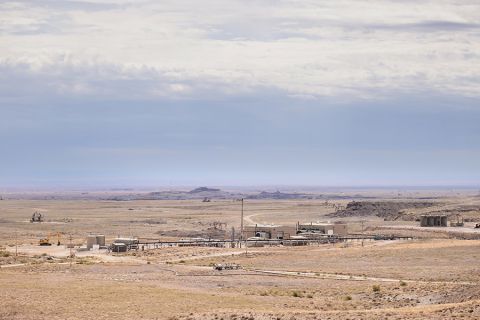
Margins tightened slightly during a relatively uneventful week at Mont Belvieu, Texas, in terms of NGL price movements.
Crude oil, however, shot up on April 11 to its highest point since December 2014 following President Donald Trump’s warning on Twitter of a coming missile strike against Syria. The assault would be in response to the recent chemical weapons attack in the city of Douma, for which the U.S. has blamed the Syrian government and Russia.
 Missile launches into Saudi Arabia from Houthi rebels in Yemen did little to calm traders’ nerves, either. Rebels claimed that their missiles were aimed at the Saudi defense ministry and the town of Najran, home to an Aramco oil distribution center.
Missile launches into Saudi Arabia from Houthi rebels in Yemen did little to calm traders’ nerves, either. Rebels claimed that their missiles were aimed at the Saudi defense ministry and the town of Najran, home to an Aramco oil distribution center.
Geopolitics aside, crude oil prices have been supported by strong fundamentals, said analysts at En*Vantage Inc. Oil inventories at Cushing, Okla., are about half of what they were a year ago, in spite of the recent build-up. Inventories are also well below the five-year average for this time of year. And with Very Large Crude Carriers loading up with oil at the LOOP terminal offshore Louisiana, U.S. exports are more than triple what they were at this time in 2017.
“In summary,” En*Vantage said, “we feel that on the fundamentals alone, crude prices should trend higher over the next several weeks.”
 The price of ethane dipped at Mont Belvieu last week but was still 7.2% higher than at this time a year ago and the margin remained above 8 cents per gallon (gal). In January, ethane inventories experienced their largest monthly decrease since January 2003. That followed a sharp drop in December, resulting in a days-of-inventory supply of 31 days, compared to 42 days in September.
The price of ethane dipped at Mont Belvieu last week but was still 7.2% higher than at this time a year ago and the margin remained above 8 cents per gallon (gal). In January, ethane inventories experienced their largest monthly decrease since January 2003. That followed a sharp drop in December, resulting in a days-of-inventory supply of 31 days, compared to 42 days in September.
En*Vantage expects that gauge to drop below 25 by July, which should drive higher ethane prices and frac spreads. At the same time, ethylene production margins are getting slimmer. Still, the analysts expect demand to be strong from the new crackers coming online and that the price will reach 35 cents/gal by the end of the year.
 In the week ended April 6, storage of natural gas in the Lower 48 experienced a decrease of 19 billion cubic feet (Bcf), compared to the Bloomberg consensus forecast of 12 Bcf, the U.S. Energy Information Administration reported. The figure resulted in a total of 1.335 trillion cubic feet (Tcf). That is 35.2% below the 2.06 Tcf figure at the same time in 2017 and 21.9% below the five-year average of 1.71 Tcf.
In the week ended April 6, storage of natural gas in the Lower 48 experienced a decrease of 19 billion cubic feet (Bcf), compared to the Bloomberg consensus forecast of 12 Bcf, the U.S. Energy Information Administration reported. The figure resulted in a total of 1.335 trillion cubic feet (Tcf). That is 35.2% below the 2.06 Tcf figure at the same time in 2017 and 21.9% below the five-year average of 1.71 Tcf.
Joseph Markman can be reached at jmarkman@hartenergy.com and @JHMarkman.
Recommended Reading
E&P Highlights: Oct. 28, 2024
2024-10-28 - Here’s a roundup of the latest E&P headlines, including a new field coming onstream and an oilfield service provider unveiling new technology.
E&P Highlights: Sept. 16, 2024
2024-09-16 - Here’s a roundup of the latest E&P headlines, with an update on Hurricane Francine and a major contract between Saipem and QatarEnergy.
E&P Highlights: Nov. 4, 2024
2024-11-05 - Here’s a roundup of the latest E&P headlines, including a major development in Brazil coming online and a large contract in Saudi Arabia.
E&P Highlights: Sept. 23, 2024
2024-09-23 - Here's a roundup of the latest E&P headlines, including Turkey receiving its first floating LNG platform and a partnership between SLB and Aramco.
Now, the Uinta: Drillers are Taking Utah’s Oily Stacked Pay Horizontal, at Last
2024-10-04 - Recently unconstrained by new rail capacity, operators are now putting laterals into the oily, western side of this long-producing basin that comes with little associated gas and little water, making it compete with the Permian Basin.
Comments
Add new comment
This conversation is moderated according to Hart Energy community rules. Please read the rules before joining the discussion. If you’re experiencing any technical problems, please contact our customer care team.





